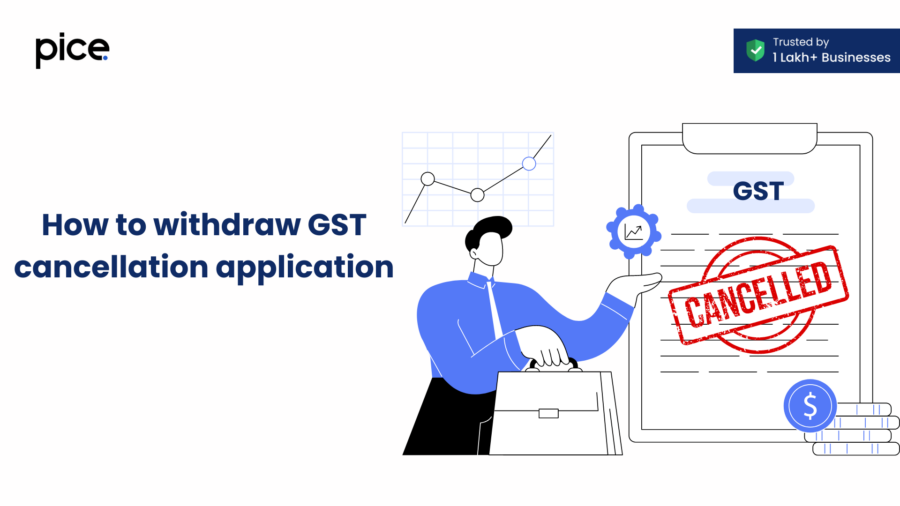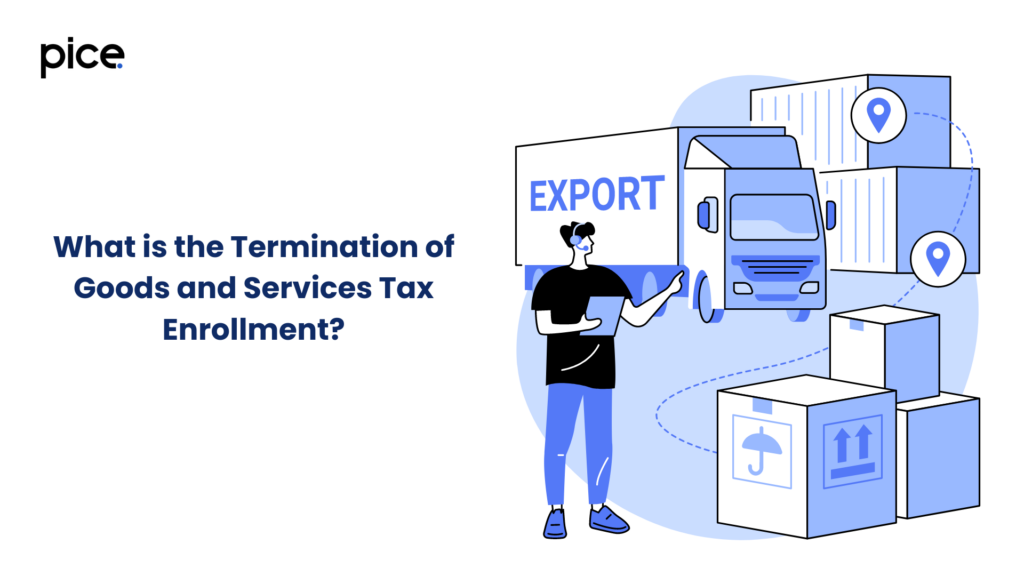How to withdraw GST Cancellation Application?
- 28 Aug 24
- 9 mins

How to withdraw GST Cancellation Application?
Key Takeaways
- Legal Compliance: GST registration is mandatory for businesses exceeding turnover limits and ensures adherence to tax laws.
- Eligibility Criteria: GST registration is required for various entities, including interstate suppliers, e-commerce operators, and agents of suppliers.
- Reasons for Termination: GST registration can be terminated due to business closure, structural changes, turnover below threshold, or non-compliance.
- Retraction of Cancellation: Businesses can withdraw their GST cancellation application by submitting a formal request through the GST portal before final approval.
- Steps to Withdraw: The withdrawal process involves logging into the GST portal, navigating to the cancellation application, filling Form REG-16, and submitting it for confirmation.
A GST cancellation application is a formal request for a taxpayer to cancel their GST registration with the Goods and Services Tax (GST) authorities. This application is typically filed when a business is no longer operational, has undergone significant changes in structure, or no longer meets the requirements for GST registration.
Cancelling GST registration can be a complex process. There may be times when a taxpayer wants to withdraw their application for cancellation of GST registration for various reasons. Here's a detailed guide on how to withdraw such an application, the reasons behind it, and the steps involved.
Why Register for Goods and Services Tax?

Registering for Goods and Services Tax (GST) is crucial for businesses in India. GST is a comprehensive tax levied on the manufacture, sale, and consumption of goods and services. It is designed to create a single, unified market and replace multiple indirect taxes. Here are the main reasons for registering:
- Legal Compliance: Mandatory for businesses with turnover exceeding the threshold limit.
- Input Tax Credit (ITC): Businesses can claim credit for the taxes paid on purchases.
- Interstate Trade: Necessary for businesses involved in interstate trade.
- E-commerce: Mandatory for online sellers.
- Credibility: Enhances the credibility of the business.
Who is Eligible to Register for Goods and Services Tax?
Eligibility for Goods and Services Tax (GST) registration in India is defined under the GST Act, and it includes various categories of businesses and individuals. Here’s an elaborated explanation of the key eligibility criteria along with relevant keywords to help understand who needs to register for GST:
Businesses with a Turnover Exceeding the Threshold Limit
- Threshold Limits: Businesses must register for GST if their annual turnover exceeds Rs. 40 lakhs for goods and Rs. 20 lakhs for services. For special category states, the threshold limit is Rs. 20 lakhs for goods and Rs. 10 lakhs for services.
- Aggregate Turnover: This includes the aggregate value of all taxable supplies, exempt supplies, exports of goods or services, and inter-state supplies of persons having the same Permanent Account Number (PAN).
Interstate Suppliers
- Interstate Supply: Any business engaged in the interstate supply of goods and services must register for GST, regardless of their annual turnover. This is mandatory to ensure compliance with the GST laws governing interstate trade.
- Taxable Territory: Interstate transactions occur when goods or services are supplied from one state to another, necessitating GST registration to ensure proper tax collection and credit.
E-commerce Operators
- E-commerce Platforms: Operators of e-commerce platforms like Amazon, Flipkart, and other online marketplaces must register for GST. This includes the platform operators themselves and the sellers who use these platforms to sell goods and services.
- Tax Collection at Source (TCS): E-commerce operators are required to collect tax at source (TCS) at the rate of 1% of the net value of taxable supplies made through their platform. This necessitates GST registration for both operators and sellers.
Casual Taxable Persons
- Occasional Businesses: Casual taxable persons who occasionally supply goods or services in a taxable territory where they don’t have a fixed place of business must register for GST. This includes entities participating in exhibitions or trade fairs.
- Temporary Registration: Casual taxable persons must apply for a temporary GST registration, which is valid for a period of 90 days and can be extended for an additional 90 days.
Non-resident Taxable Persons
- Non-residents in Business: Non-resident individuals or businesses supplying goods or services in India must register for GST, regardless of their turnover. This includes foreign entities conducting business transactions within India.
- Temporary Registration: Non-resident taxable persons need to apply for a temporary GST registration, which is valid for a specified period and is mandatory for conducting business in India.
Agents of Suppliers and Input Service Distributors
- Agents of Suppliers: Individuals or entities acting as agents for suppliers must register for GST. This includes commission agents, brokers, and other representatives involved in the supply chain.
- Input Service Distributors (ISD): Businesses that distribute input tax credit to their branches having the same PAN must register as an ISD. This facilitates the proper distribution and utilization of input tax credits among branches.
Additional Categories Requiring GST Registration
- Reverse Charge Mechanism: Businesses required to pay tax under the reverse charge mechanism must register for GST. This includes cases where the recipient is liable to pay GST instead of the supplier.
- Tax Deduction at Source (TDS): Certain entities required to deduct tax at source under GST must register. This applies to government agencies, public sector undertakings, and certain notified persons.
- Voluntary Registration: Businesses not meeting the mandatory criteria can also opt for voluntary registration under GST. This allows them to avail benefits like input tax credit and enhance their business credibility.
What is the Termination of Goods and Services Tax Enrollment?

Termination of GST enrollment refers to the cancellation of GST registration. This can happen for various reasons, such as business closure, change in business structure, or turnover falling below the threshold limit.
Reasons for Goods and Services Tax Termination
Termination of GST registration can occur for various reasons. These include:
- Business Closure: When a business is closed or transferred, GST registration must be terminated to cease tax obligations.
- Change in Business Structure: Mergers, demergers, or significant restructuring necessitate the termination of existing GST registration and obtaining new registration.
- Turnover Below Threshold: If a business's annual turnover falls below the mandatory registration limits (Rs. 40 lakhs for goods, Rs. 20 lakhs for services), it can apply for GST termination.
- Violation of GST Laws: Non-compliance or fraudulent activities, such as failing to file returns or tax evasion, can lead to cancellation by tax officials.
- Voluntary Cancellation: Taxpayers may request voluntary cancellation when GST registration is no longer required due to changes in business operations or models.
Termination of Retraction of Goods and Services Tax Enrollment
Termination of retraction of GST enrollment refers to the process where a registered taxpayer withdraws their application for the cancellation of GST registration. This can occur for various reasons and involves specific steps and considerations.
- Registered Taxpayer: Any business or individual that has registered for GST and subsequently applied for cancellation can retract this application.
- Time Period: The withdrawal of the cancellation application must be done within the stipulated time period before the final approval of the cancellation by the tax authorities.
- Application for GST Registration: The initial application for GST registration and its subsequent cancellation or retraction involve forms and procedures such as Form GST REG-16.
- Fresh Application: If the business circumstances change, a fresh application for GST registration may be necessary after the retraction of the cancellation.
- Withdrawal of Application: To withdraw the cancellation application, the registered taxpayer must submit a formal request through the GST portal, ensuring all relevant details are accurately provided.
- Application for Retraction: This specific application process involves retracting the initial cancellation request, often due to changes in business operations or other strategic reasons.
Steps to Withdraw Application for Cancellation of GST Registration
Withdrawing an application for cancellation of GST registration involves the following steps:
Step 1: Login to GST Portal: Access the GST portal using your login credentials.
Step 2: Navigate to Services: Go to 'Services' > 'Registration' > 'Application for Cancellation of Registration'.
Step 3: Select the Application: Choose the application you wish to withdraw.
Step 4: Fill Form REG-16: Complete the necessary details in Form REG-16.
Step 5: Submit the Form: Submit the form after verifying the details.
Step 6: Confirmation: Await confirmation from the tax authorities.
Retraction Application Differences
It's important to understand the differences between retraction applications and other types of applications, such as revocation applications:
- Retraction Application: Withdraws the application for cancellation before it is processed.
- Revocation Application: Reverses a completed cancellation, often due to non-compliance rectification.
Conclusion
Withdrawing an application for the cancellation of GST registration is an essential process for businesses that need to maintain their GST registration. By following the appropriate steps and understanding the reasons and implications, businesses can ensure compliance and continuity in their operations.
💡If you want to pay your GST with Credit Card, then download Pice Business Payment App. Pice is the one stop app for all paying all your business expenses.
 By
By 

















